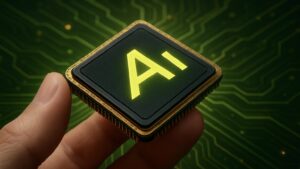The digital revolution that propels our modern era is built upon three basic elements: chips, semiconductors, and integrated circuits. Though interconnected, they are each different technological ideas having a specific, unique application in electronic devices. From transistor manufacturing, the semiconductor field has evolved into producing complex systems with billions of parts on substrates the size of fingernails. This expansion has made possible smartphones, autonomous cars, AI, and a thousand other technologies that define contemporary life. The article explores the major differences between the three pillars of technology and how their roles in our rapidly digitizing world have evolved.
| Aspect | Semiconductors | Integrated Circuits (ICs) | Chips |
| Definition | An electrical material with conductivity between that of a conductor and an insulator (e.g., silicon, GaAs). | A small electronic circuit made up of transistors, resistors, and capacitors formed on a semiconductor base. | A packaged hardware component that contains one or more integrated circuits, ready for use in devices. |
| Primary Function | Acts as the base material enabling controlled electrical conductivity. | Performs specific electronic functions like logic processing, memory storage, or signal amplification. | Operates as the final, functional unit embedded into electronic products. |
| State/Form | Raw or processed crystalline material (e.g., wafers made from pure silicon). | Microscopic electronic structures fabricated on a semiconductor wafer. | Finished and packaged unit with pins, connectors, and protective casing. |
| Fabrication Process | Produced via purification, doping, and crystallization of silicon or other semiconductors. | Created through photolithography, doping, etching, and deposition to form circuit elements. | Involves die cutting, packaging, bonding, and final testing of functional ICs. |
| Contains Other Elements? | No — it is a material, not a circuit. | Yes — contains multiple components like transistors, logic gates, capacitors, etc., integrated into a system. | Yes — may contain one or more ICs and sometimes additional elements like memory or I/O controllers. |
| Examples | Silicon wafer, gallium arsenide crystal. | Logic gate array, microcontroller core, analog amplifier. | Intel Core i9, Apple M-series chip, NVIDIA GPU, Qualcomm Snapdragon SoC. |
| Used In | Base for all electronic devices, not used directly by end-users. | Embedded in computing devices, smartphones, appliances, and other electronics. | Installed into final products like laptops, smartphones, automotive systems, and servers. |
| Scope of Term | Refers to the material science and electrical behavior of elements like silicon. | Refers to the design and arrangement of components within a system on a chip. | Indicates the physical, ready-to-use unit that gets integrated into hardware systems. |
The Foundation: Semiconductor Materials
The journey from sand to silicon wafers involves complex processes. These convert materials into the backbone of modern technology. So, let’s observe how semiconductor materials constitute the base on which our entire virtual world stands:
What Makes Semiconductor “Semi” Conductive
Semiconductors are neither purely conductors nor pure insulators. Engineers can easily control their electrical conductivity. Silicon is the standard in the industry due to its abundance as well as its perfect electronic properties, most notable of which is its four valence electrons that are in use to create perfect covalent bonds. Silicon can also have its conductivity altered in stable manners when it is doped with minor impurities such as phosphorus or boron. This enables the creation of P-type and N-type regions that electronic devices need. Therefore, this variable conductivity is the basis of all electronics today.
Producing Pure Silicon: From Sand to Wafers
The journey starts with quartz sand (silicon dioxide), which is carburized by carbon to yield metallurgical-grade silicon with 98% purity. For application of electronics, the silicon finds further refinement through the Siemens process or zone refining to give 99.9999999% purity (9N). Furthermore, the purified silicon gets melted and crystallized to form single-crystal ingots. This is through the process of Czochralski and then is cut into slices, thin wafers. They are lapped to mirror finishes with thickness tolerances in microns and are suitable substrates for subsequent manufacturing processes.
The Physics of Semiconductor Operation
Semiconductor operation is founded on the laws of quantum physics, namely band gap theory. Semiconductors are different from metals with overlapping energy bands. They have a very narrow energy gap between valence and conduction bands. This space allows for electron mobility to find control with doping and application of an external voltage. Moreover, the P-N junction, where regions of different doping meet, creates a depletion region. This enables current to flow in one direction—the fundamental principle of diodes and transistors. Temperature response and photovoltaic effects also explain the behavior of semiconductors in many applications.
Modern Semiconductor Materials beyond Silicon
Although silicon reigns supreme in commercial use, there are special semiconductors with benefits for particular applications. Gallium arsenide (GaAs) possesses better electron mobility and direct band gap characteristics. They are especially powerful for high-frequency devices/ optoelectronics. In addition, gallium nitride (GaN) & silicon carbide (SiC) are great for high-power, high-temperature applications. It includes electric vehicle power systems. Additionally, new materials encompass graphene with superb electron mobility and III-V compounds for specialized use. Research also continues with the use of quantum dot materials that may provide next-generation computing and sensing capabilities.
From Transistors to Integrated Circuits
The transition from discrete transistors to intricate integrated circuits is one of the most remarkable technological feats. This expansion has allowed for exponentially vast growth in computing while consistently diminishing physical dimensions. So, let us view this development in detail:
The Transistor Revolution: Building Blocks of Electronics
Transistors function both as electronic amplifiers and electronic switches, which are the bare minimum building blocks of all computer technology. The bipolar junction transistor (BJT) was the first commercially successful design. It was developed in 1947. In addition, Metal-oxide-semiconductor field-effect transistors (MOSFETs) subsequently became the standard. This is because they took less power and were better in sizing. Moreover, a single transistor can perform basic logic functions, and multiple transistors combined create higher-level functions. Transistors have come down to the nanometer scale now, and billions are there on a single chip. So, this depicts the huge miniaturization of which the available computing power is a testament.
Integrated Circuit Architecture: Integration of Components
Integrated circuits (ICs) consolidate several electronic components. It includes transistors, resistors, capacitors, and interconnects on a single semiconductor substrate. Jack Kilby & Robert Noyce independently conceived this thought during the late 1950s, revolutionizing electronics. Further, contemporary ICs employ sophisticated architectures with various levels of interconnect layers. Additionally, Boolean operations are executed by logic circuits based on transistor configurations, and memory circuits hold data by employing multiple distinct technologies. Moreover, analog-digital conversion, signal processing, and communications protocols are handled by dedicated circuit blocks. This convergence also offers higher functionality in a trusted form via standardized manufacturing processes. This is how integrated circuits differ from semiconductors and chips.
Scaling Challenges and Moore’s Law
Gordon Moore’s 1965 observation that transistor density doubles every two years has guided industry development for more than three decades. This incredible growth has driven processing power and a minimization of costs, which evolved from specialized hardware to ubiquitous technology. However, physical constraints are making it challenging to scale further. Atomic-scale dimensions create quantum tunneling effects, heat dissipation becomes challenging with growing densities, and photolithography is reaching wavelength limitations. The technology compensates for the same by bringing in innovations such as FinFET transistors, extreme ultraviolet lithography, and three-dimensional integration. It contributes to establishing continuous performance improvement over conventional scaling approaches.
Specialized Integrated Circuits: ASICs, FPGAs, and SoCs
Application-Specific Integrated Circuits (ASICs) power performance for individual applications. It encompasses cryptocurrency mining or machine learning with application-specific design. This eliminates the unnecessary components. Field-Programmable Gate Arrays (FPGAs) also offer reconfigurable logic blocks. They can find reutilization for new purposes with flexibility & performance balance. Further, System-on-Chip (SoC) designs combine complete computer systems. It includes processor cores, memory, I/O controllers, and accelerators on a single chip. Thus, such specialty techniques allow bespoke solutions for certain tasks. This is with maintaining the efficiency advantages of integrated circuit technology for different computing requirements.
The Final Product: Chips
The end product of the production of semiconductors is chips that drive our technologically equipped world. This segment examines the process whereby raw materials transform into the final products required for contemporary technology:
Semiconductor Fabrication: The Cleanroom Process
Chip manufacturing occurs in ultra-clean cleanrooms where airborne contamination goes to near-zero. It begins with photolithography, when UV light stamps circuit patterns onto photoresist-coated silicon wafers. Furthermore, multiple etching, deposition, doping, and metallization processes layer up the complex layered structures. Moreover, modern chips entail hundreds of carefully controlled processing steps, and some advanced devices with over 1,000 distinct stages of production. The accuracy involved is so high that chip fabrication is among the most technically challenging manufacturing processes. This is with tolerances having measurements in nanometers—less than a virus.
From Die to Package: Assembling the Chip
After being produced, the wafer contains hundreds of identical dies (single chips) that are electrically tested to identify which ones are faulty. Functional dies then find separation from the wafer using diamond saws or laser cutting. These bare dies are extremely delicate and require protective packaging. These not only protect them from the environment but also make electrical connections with the external systems. Moreover, new packaging technologies range from plastic encapsulation to sophisticated flip-chip and through-silicon via designs that maximize the electrical performance. Additionally, the final packaged chips undergo extensive reliability testing before shipping. It ensures that they meet performance specifications across a broad range of environmental conditions.
Embedded Systems vs. General Computing Chips
Specialized chip designs are required for different applications. General-purpose computing processors (CPUs) focus on flexibility, with instruction sets serving varied workloads and intricate pipelines for high-end computing. Furthermore, embedded system chips focus on power consumption, deterministic operation, and custom interfaces for specific uses. It includes automotive control units or medical instruments. Moreover, microcontrollers combine processing, memory, and I/O onto single chips for embedded use. This is while graphics processing units (GPUs) exploit enormous parallelism for compute-intensive applications. So, each chip category embodies different design philosophies targeted at particular application scenarios.
Directions for the Future: Quantum, Neuromorphic, and Beyond
Modern technologies are transforming the production of semiconductors beyond conventional ways. Quantum computing takes advantage of quantum mechanical effects such as entanglement, superposition, etc. It solves issues not possible on conventional computers. Additionally, neuromorphic chips simulate brain structure with synthetic synapses and neurons. This provides energy-efficient machine learning functionality. Moreover, three-dimensional integration stacks silicon layers on top of each other vertically to add density without decreasing feature sizes. Also, carbon electronics based on graphene and carbon nanotubes promise to stretch performance beyond silicon’s physical limits. So, these advances indicate semiconductors will keep advancing far beyond today’s technical boundaries.
To Sum Up
The differences among semiconductors, integrated circuits, and chips disclose the staggering complexity behind today’s electronics. Semiconductors give the critical material basis with controllable electrical characteristics. Integrated circuits place multiple elements into working systems on semiconductor substrates. Moreover, chips are the finished packaged products, which facilitate innumerable applications. Comprehension of these distinctions offers the key to insight into the technologies shaping our future digital world. With advancements in technology still unfolding in materials science, manufacturing, and building methodologies, the semiconductor industry will also continue to break boundaries in determining what is technically possible in computerizing, communication, and automating.
Ready to dig deeper into this exciting sector? Attend the next International Semiconductor Summit. This is where industry leaders will share the newest on future technologies, market trends, and innovation for next-generation electronic products. Join now!


